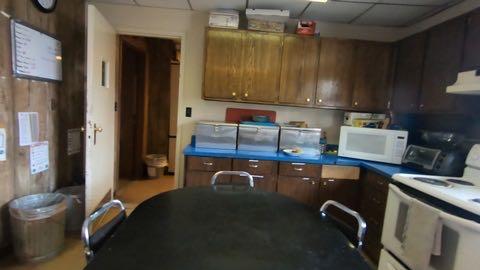 McMurdo Fire Station
McMurdo Fire Station
A special Thank You to William Newtown and Captain Steven Kilpatrick for the oportunity to tour the McMurdo Fire Station.
 McMurdo Engine #1
McMurdo Engine #1
McMurdo Fire Station has two engines, in case something goes wrong with the first engine; if there is a big fire on base and they need to do an “all call” where all firefighters on-base respond, or the other engine is already responding to an emergency. When a fire engine is dispatched there are always at least three people on board: a driver, officer, and firefighter. There are also two ambulance vans. An ambulance always has two individuals, a driver and an EMT.
 New Zealand's Scott Base
New Zealand's Scott Base
The McMurdo fire department does not only work on our base, they work as mutual aid with the New Zealand Scott Base, as well. Scott base is approximately 2 miles from McMurdo.
In case of a fire, there are 8 fire hydrants on base, which each have a 4-inch main, where the hose attaches. This is smaller than the fire hydrant mains back in the USA. (I looked for multiple days for these fire hydrants, later to be told that they keep them covered when not in use :) )The fire hoses are constructed of the same materials that your local fire department use, however, they are thinner, only 3 inches wide, due to the smaller main. The water to the hydrants is supplied by the McMurdo station water plant.
 Back of Engine 1 with hoses on top
Back of Engine 1 with hoses on top
They carry two 1,000 foot hoses on top of the truck, one specifically folded in case they park in front of or behind the hydrant. I found it really interesting that firemen have to do math in the field. The length of hose that is needed determines the amount of friction in the hose, the longer the hose the less friction. Knowing the length of the hose a firefighter calculates the amount of pressure that has to be used to support water flow.
I asked, does the water ever freeze? As long as the water keeps moving it doesn’t freeze. Anytime that a fire hydrant is open a plumber also reports to the scene to make sure the fire hydrants are resealed properly and are completely dry so they aren’t frozen for future use. The department inspects one fire hydrant a day to make sure there are no frozen caps or levers; they do not flow from the hydrants during these checks.
The firefighters wear the same suit as your local fire department. The heavy outerwear helps against the strong Antarctic winds and they are moving around a lot to stay warm. If they were to wear materials to keep them warm they may become superheated and melt an obvious very unsafe situation.
The trucks do have a few modifications. They are ARF, Airport Rescue Firefighting, trucks which means they are a little taller than an average firetruck. There is a switch that can make it so the tires are always turning on chains, which makes it easier to drive if the local road conditions are icy or snowy. And not only does the truck carry 2000 gallons of water it carries 50 gallons of special foam that is specific to Antarctica, it has a lower freezing point than the foam that trucks carry in warmer climates.
 Tools on firetruck
Tools on firetruck
This picture shows one of the many tool areas on the truck. McMurdo Fire Department can be called to work with the Spills Department on base. We are very environmentally friendly and even a couple drips of gasoline that fall from the pump as someone is hanging the nozzle back in place are shoveled up and properly disposed of. This area also contains tools like a closet hook, axe, and halligan which are used during fires and after to check for any little flames that may rekindle.
 Fire Station Kitchen
Fire Station Kitchen
The firefighters have 24-hour shifts. During that time they cook family-style meals. I knew they could not just go to a grocery store to pick up food, so I asked where they get their ingredients. The department puts in a food order through the McMurdo Station kitchen and sometimes individuals even bring food on their flights down from Christchurch. During their 24-hour shift, they may also sleep in rooms with bunk beds. This is different from their primary residence, which is a dorm room that is often shared with another member of the department.
An interesting fact about the Firefighter staff: The department is trained on animal herding. Just in case an animal like a Weddell seal needs to be moved for their own safety.


Comments
Add new comment